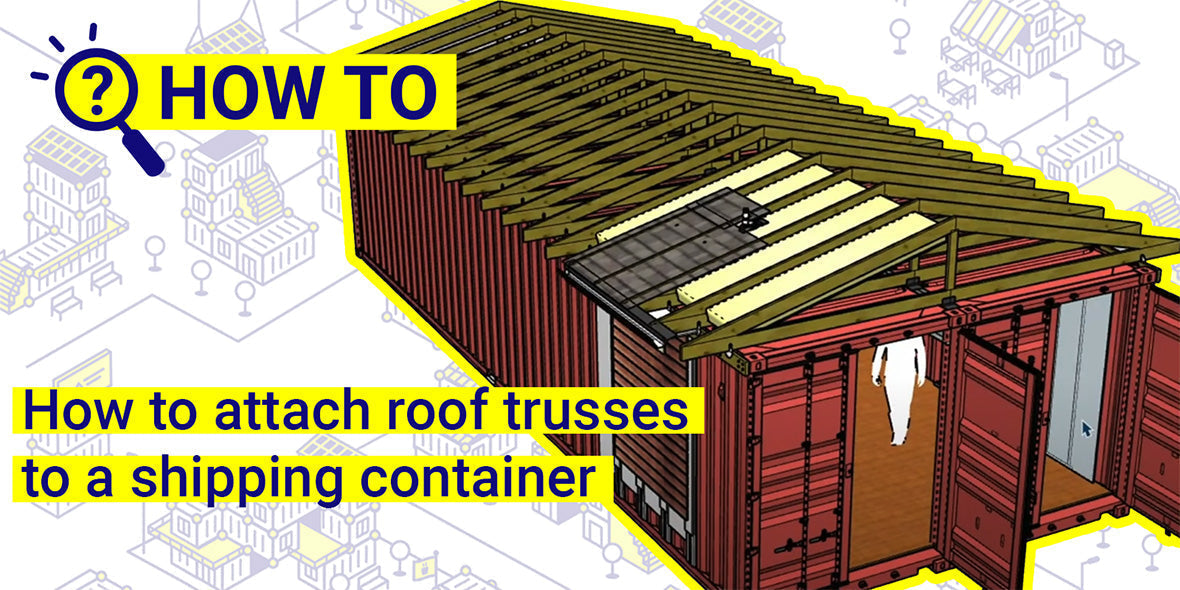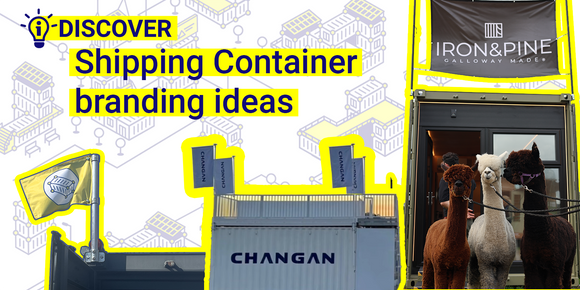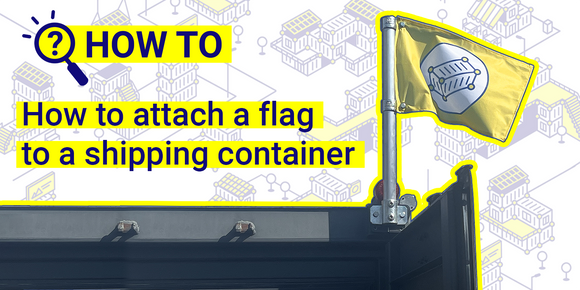
How to attach roof trusses to a shipping container
If you’re wondering how to attach roof trusses to a shipping container, the good news is you don’t need to cut, weld, or compromise the container’s structure or its watertight seal. In this guide, we’ll show you a simple 5-step process using Domino Clamps and roof brackets to create a strong roof frame.
This method was demonstrated by American Institute of Architects member, Larry Lane, in his YouTube channel Live in a Container, where he shows how to use Domino Clamps (along with a few other products) to build a pitched roof on two joined shipping containers.
We’d like to point out that this video was not a paid promotion, nor did we ask him to make the video, but we found it, and we love seeing how our products are used for all types of container conversions. We think you may find it helpful for your roof project.

Step-by-Step: How to Attach Roof Trusses to a Shipping Container
Here’s the simplified process Larry shows in his video. You can also watch the full tutorial in the video below the instructions.
Tip: If you plan to add roof trusses to two containers joined side by side, the full video shows how to join and secure them properly. The same principle can be applied when using one container, or even more.
-
Fix Domino Clamps into the corner castings
Domino Clamps lock into the container’s existing corner castings, giving you a secure anchor point without damaging the steel walls. -
Add roof brackets along the side
Use roof brackets to grip the top side rails. Make sure these are tightened securely (using lock washers) before moving on.
See our full guide on how to use this roof bracket for your container conversions here.
-
Secure a roof support timber
A 2x6 nailer board or horizontal timber is bolted into the Domino Clamps and the additional roof brackets, creating a strong fixing surface for the trusses along the sides of the container.
-
Attach the roof trusses
Use joist hangers to fix the trusses to the nailer beam and support them across the span.
-
Finish the roof
Add insulation, siding, sheathing, and finally your chosen roofing material.
Watch the detailed instructions here on Larry’s YouTube channel Live in a Container:
Materials You’ll Need
- Domino Clamps (to create strong fixing points)
- Shipping container roof brackets (for extra support along the side)
- Roof support timber (likely 2x6, 2x8 or 2x10 word)
- Roof trusses (prefab or custom-built)
- Joist hangers
- Insulation, siding, and roofing materials

Domino Clamps and roof brackets attached to the container in preparation for adding the roof support timber
Two ideas for your roof truss project
Roof trusses can be added to containers in a number of ways. The video above shows a double-pitched roof over two containers joined together, which is ideal for a small home garage or tiny home, but it can also be useful to create one large roof to span two containers with an open area between them that can be used as a workshop area or carport. More or less the same techniques can be used to achieve both solutions.
Trusses over a single container

Trusses spanning two containers with a central gap
Spacing the containers apart creates a wider covered area as you can see here for this smallholding project where a large metal roof spans two 40ft containers

Why Use Domino Clamps Instead of Welding or Drilling?
Some people will suggest welding plates or drilling through the container when they want to attach roof trusses. The problem is that both of those methods come with downsides. Welding can distort or weaken the frame, and drilling holes through the walls or side rails breaks the watertight seal of the container. It also means once you’ve made those holes, you’re stuck with them, which is not ideal if you ever want to change or move things later. Containers are made with Corten steel, which can be a lot trickier to weld than mild steel, and in many places is subject to specific and more stringent welding codes and procedures. Finding a welder good enough to carry out such work can easily become more expensive than the Domino Clamps.
Advantages and disadvantages of welding versus using Domino Clamps
| WELDING / DRILLING | DOMINO CLAMPS |
| Requires expensive specialist tools and skill | Requires a 10mm hex key and no skill |
| Damages the container | No damage to the container |
| Invalidates the container CSC | Container holds its value as it maintains its CSC |
| Each weld needs to be cut off if dismantled | Can be dismantled and relocated many times |
| Welds may need checking or certifying for strength | Domino Clamps come with 2000kg NWL |
| Corten steel is not as easy to weld as mild steel, and may need to meet N 1011 or AWS D1.1 to comply with local structural regulations | Classed as a non-permanent fixture, Domino clamps often need not comply with building regulations |
Domino Clamps solves these problems by making use of the corner castings that are already built into every container. That gives you a solid, removable fixing point for your trusses, without cutting, drilling or damaging the container itself.
Looking for inspiration?
If you’re still exploring ideas, take a look at
- our article on building a big metal roof between two shipping containers,
- or see the different roof ideas our customers have had and built.
Final Thoughts
Learning how to build a roof and attach roof trusses to a shipping container opens up a whole new set of possibilities for your container build. By using Domino Clamps, you can add a secure roof without compromising the structure of your container.
If you’re planning a project, take a look at our range of Domino Clamps and shipping container accessories, and don’t forget to watch the Live in a Container video to see the instructions in action.
Need a solid fixing point for timber? Here’s our guide on how to attach wood to a shipping container with Domino Clamps.
Frequently Asked Questions
Here are some common questions we get about attaching roof trusses to containers. If you’ve got another question, just leave a comment below and we’ll be happy to get back to you.
Can I attach roof trusses to a single container, or do I need two joined together?
Both options are possible. With one container, you fix the trusses directly to the side rails and corner castings. With two containers side by side, you’ll need to support the middle span as shown in the Live in a Container video.
Do I need to weld or cut into my container to attach trusses?
No. With Domino Clamps and roof brackets you can build a complete roof frame without welding, drilling, or cutting into the steel. This keeps the container watertight and avoids permanent alterations or future problems with leaks.
Do I need a structural engineer to attach roof trusses to a shipping container?
Yes, in most cases it’s a good idea or it can even be required. A structural engineer can check that your roof design is safe and complies with local building codes. This is especially important if you live in an area with heavy snow, high winds, or if you’re combining multiple containers.
Will using Domino Clamps be strong enough compared to welding?
Yes. Domino Clamps lock into the container’s corner castings — the strongest part of the structure — giving you a secure fixing point without weakening the walls. The container stays watertight and unaltered, and with our roof brackets along the long sides, you get extra support to spread the load.
What are the alternatives to using Domino Clamps?
Some builders weld plates or drill through the side rails to bolt timber directly. Both methods can work, but welding risks distorting the steel, and drilling breaks the watertight seal. Once done, those alterations are permanent - unlike Domino Clamps, which are removable and reusable.





